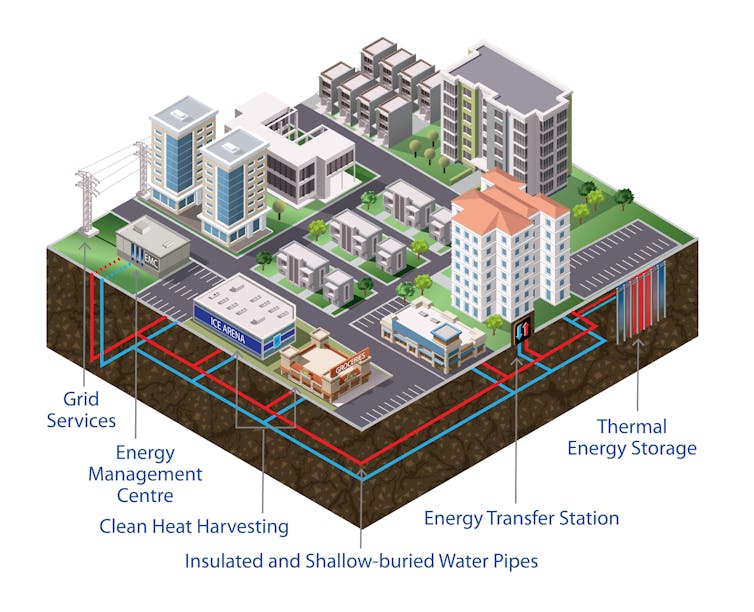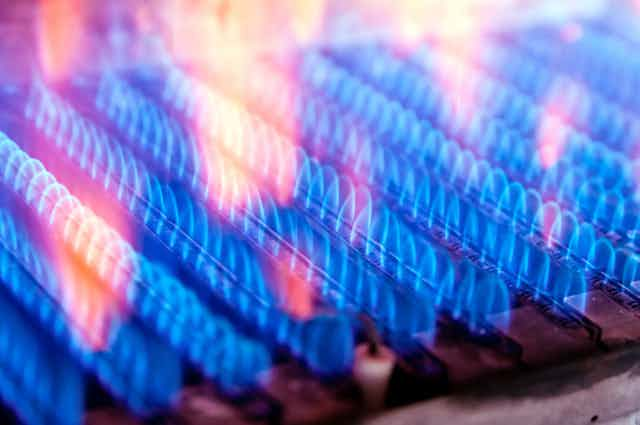Most of us who live in the Northern Hemisphere have a fundamental problem: we want to reduce our carbon emissions, but we also need to heat our homes.
The good news is there is a way to do both by creating thermal networks. A thermal network is a system of insulated, underground pipes that directly distribute heat to homes and other buildings using heat generated from clean sources — including nuclear reactors.
Rather than using their own furnaces, boilers, fireplaces or electric baseboard heaters to heat buildings, consumers would receive heat directly from a utility.
It’s an opportunity that is set to grow as Canada expands its nuclear energy supply and creates more heat in the process, especially with small modular reactors expected to start coming on-stream in the next decade.
Read more: Are small nuclear reactors the solution to Canada’s net-zero ambitions?
Scaling up
Our research collaboration has produced — with the help of experts from McMaster University, The Boltzmann Institute and Canadian Nuclear Association — a position paper presenting the case for large-scale thermal networks to be created across Canada, with nuclear power plants potentially providing up to half of the heat.
Similar technology using heat from non-nuclear sources is already a reality in Canada in the form of district energy systems.
Many buildings in Toronto, Hamilton, Vancouver and on university campuses, such as McMaster University, are served by hot water or steam-based central heating plants, using heat that is purpose-made and piped across campus. What’s more, Canada already leads the world in district cooling networks.
Thirteen states in the United States are implementing a thermal networks utility model. In Europe, 67 million people enjoy heating from thermal networks and district heating systems supplied by a variety of sources in a mix that is increasingly less reliant on carbon.
The idea is catching on, and it’s time to scale up.
Leftover heat
As many as 70 per cent of Canadians live in communities that could be warmed by thermal networks. The networks would deliver heated water that warms buildings in the same way household radiators distribute heat — but on a much larger public scale.
Such systems are capable of efficiently sending heat through buried pipelines to homes, schools, hospitals, office buildings, shopping malls and other structures, greatly reducing the demand for electricity and heating fuel and making space on the electrical grid to accommodate growing electricity demand from electric vehicle chargers and heat pumps.
One of the most appealing aspects of this opportunity is that most of the required heat is already available and going unused. Heat from major sources, such as nuclear power plants, can be transmitted as far as 100 km to where it is needed.
Québec, Alberta, Saskatchewan and New Brunswick are all considering building new or re-starting existing reactors. Together with existing reactors, much of Canada’s population would fall within this range.
In the case of reactors, thermal networks could share their useful leftover heat instead of releasing it into the environment as is typically done today. This water, used in coiling, gathers heat but does not come into contact with nuclear material and is in no way contaminated.

The recent joint declaration at the UN climate conference COP28 to triple nuclear energy capacity by 2050 means there will be significantly more heat from large reactors, such as the new nuclear fleet proposed in Ontario, which could supply warmth to homes in the Greater Toronto Area.
Small modular reactors, which are expected to come on-stream widely as local alternatives to fuel-burning sources of electricity, could supply heat locally while also generating revenue from heat that would otherwise be wasted.
Alternatively, residual heat from restaurants, commercial and industrial processes, water heated by solar or geothermal energy, or the combustion of dried biomass can do exactly the same thing with little to no greenhouse gas emissions.
Funding the change
Though our appetite for thermal networks is growing, apprehension over the cost of creating large-scale public systems has stifled enthusiasm for implementing them here.
Certainly, the challenge of laying new pipelines to every urban home is daunting, but that need not be a barrier. It’s not that long ago that water, electricity and natural gas were not delivered directly to homes and other buildings, either.
The managers of those utilities, both public and private, developed efficient methods for deployment, balanced the cost of their infrastructure over decades and included the financing costs in customers’ bills. All of these techniques could help build thermal networks across Canada.
Read more: Why we need to reuse waste energy to achieve net-zero heating systems
Natural gas only started to become commonly available in Canada in the 1950s, with networks of buried pipes being extended to the most populated areas of the country through the 1980s. Before then, people had oil, coal or wood delivered, or used electricity from coal-fired plants — all of them significant sources of greenhouse gases.
The conversion made heating cheaper and cleaner. It halved our carbon emissions. It required a huge effort, but it happened, and it can happen again.
Thermal networks present an opportunity to harvest heat from natural sources or heat that would otherwise be wasted and use it for a vital purpose of keeping Canadians warm while helping to reduce carbon emissions.

